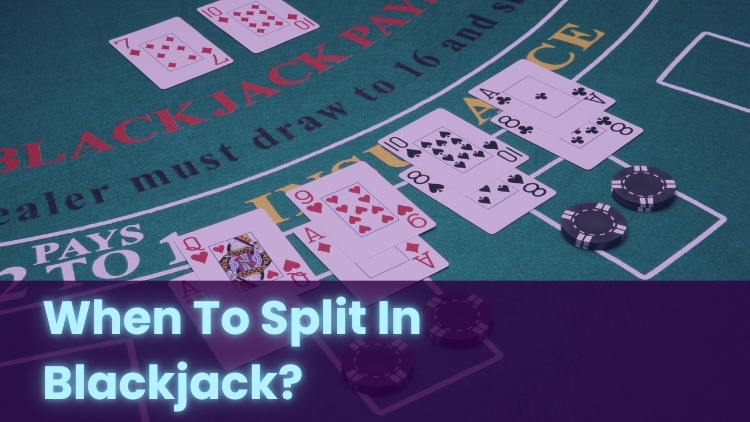
In blackjack, splitting isn’t just about chance but a thoughtful strategy that experienced players use to give themselves the best opportunity to win.
You may have seen other players splitting their cards and wondered what strategy they are using to make these decisions. These moves are based on clear principles that you can learn to apply in your own game.
In this blog post, we'll explain what splitting is in blackjack while explaining the rules in simple terms, allowing you to learn and potentially apply splitting to your own strategy.
What Is Split In Blackjack?
Splitting is a move that allows you to turn cards of equal value into two separate hands, giving you a chance to potentially double your winnings. It's important to note that you can only split when your first two cards are a pair, like two 8s or two kings.
When you decide to split a pair, you'll need to place an additional bet equal to your original wager. This creates a second hand, and you’ll play each hand separately against the dealer.
Imagine you are dealt two 7s by the dealer. By splitting them, you have the opportunity to play two hands instead of one, which could potentially improve your chances of getting at least one strong hand.
When Should You Split In Blackjack?
Knowing when to split in blackjack is all about the cards you and the dealer are holding, as some pairings are generally better options for splitting, potentially giving you a strategic edge.
One of the most common pairs to split is a pair of 8s. If you start with two 8s, you have a total of 16, which is a tricky hand as you could potentially go bust if you hit again. By splitting, you have a better chance of reaching a total of 18 or higher for each hand.
Another hand often split is two aces. Starting with two aces gives you a very flexible hand, as each ace can count as either 1 or 11. Splitting them allows you to potentially hit two powerful hands at the beginning of the hand.
On the other hand, there are certain pairs you should avoid splitting. For instance, when you have two 10s, it's usually best to keep them together, as a total of 20 is a high-scoring hand in blackjack, and splitting would risk breaking up a strong hand.
In addition, you should avoid splitting face cards and 5s. Face cards have a value of 10, which means you start with a very strong hand. Holding two hands means you start with a total of 10, meaning you could potentially have a strong hand after hitting.
Split Rules Blackjack
Understanding how splitting works in blackjack can help you make more informed decisions when you play. Keep reading to learn the rules of blackjack, helping you improve your knowledge of the game.
You can only split your hand when you’re dealt two identical cards. For instance, if you’re dealt two 9s or two queens, you’ll have the option to split them into two separate hands.
If you decide to split, you’ll need to place an additional bet that’s the same as your original wager, meaning you’ll now be playing two hands, and each hand will be played separately against the dealer.
Most casinos have rules about how many times you’re allowed to split. Usually, you can split up to three times, giving you a total of four hands; however, these rules can vary, so it’s always worth checking the specific rules at the casino where you’re playing.
After you split, each of your new hands will receive one extra card. From there, you play each hand as you would normally.
Be aware that some casinos have specific rules for splitting aces, often limiting you to just one additional card for each split ace, so it is vital you check the specific rules before playing.
Disadvantages Of Splitting Cards In Blackjack
Splitting cards in blackjack can be a useful strategy, but it’s important to understand the risks involved to ensure you make more informed decisions and avoid potentially costly mistakes.
When you split, you have to double your original bet because you’re now playing two hands instead of one, meaning you’re risking more money.
The cards you are dealt are down to chance, so splitting could potentially mean you build up losses quite quickly. Always ensure you are playing with a budget that is within your means and are comfortable with the risk involved.
It’s also important to know that splitting doesn’t always improve your chances. For example, if you split a pair of 4s, you may end up with two weak hands instead of one stronger hand, which potentially can lower your odds of beating the dealer.
There are also times when splitting may not be the ideal choice. If the dealer’s face-up card is strong, like a 10 or an ace, they’re more likely to have a high-scoring hand, so splitting could leave you at a disadvantage.
Learning the rules of splitting in blackjack and how to implement them into your strategy can help improve your blackjack experience. In addition, ensure you are playing at a venue or on a platform that is licenced by the UK Gambling Commission (UKGC) for a safe and secure gaming session.
Always remember to gamble responsibly for an enjoyable blackjack experience. Ensure your experience remains safe and enjoyable by setting limits to your playing time, sticking to a strict budget within your means and making use of any responsible gambling tools available.
*All values (Bet Levels, Maximum Wins, etc.) mentioned in relation to this game are subject to change at any time. Game features mentioned may not be available in some jurisdictions.
**The information provided in this blog is intended for educational purposes and should not be construed as betting advice or a guarantee of success. Always gamble responsibly.
